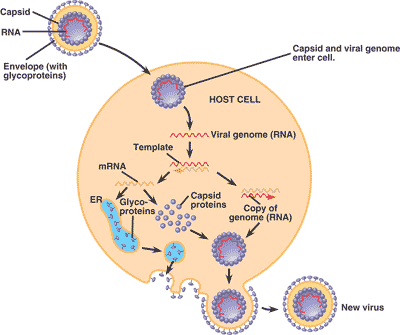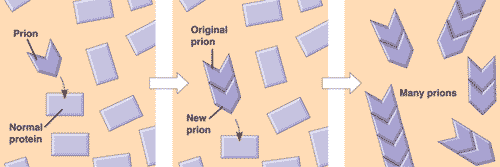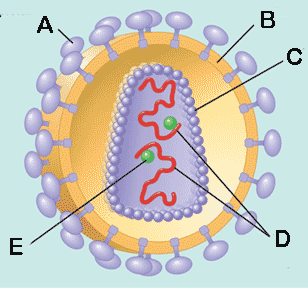| A | B |
|---|
| The name of the late stages of HIV infection, defined by a specific reduction of T cells and the appearance of characteristic secondary infections. | AIDS (acquired immunodeficiency syndrome) p388 |
| AIDS stands for _____. | Acquired immunodeficiency syndrome p388 |
| The name of the virus that can lead to AIDS is called ____. | HIV (human immunodeficiency virus) p388,  |
| HIV stands for _____. | human immunodeficiency virus p388,  |
| ______ is an enzyme encoded by some certain viri (retroviri) that use RNA as a template for DNA synthesis. | Reverse transcriptase (The HIV virus pictured below is a retrovirus. Notice the reverse transcriptase and how it is used once in the host cell) p389,  |
| A(n) _______ is a membrane that surrounds the capsid of some viri. | viral envelope (The picture below shows how viri acquire a viral envelope from the membrane of the host with extra components coded for by the virus) pp383&387,  |
| A(n) _____ is a virus that infects bacteria. | bacteriophage (can also be called "phage") p383,  |
| A phage is a _________. | virus that infects bacteria (a.k.a. bacteriophage) p383,  |
| A(n) _______ phage is a phage virus that reproduces only by a lytic cycle. | virulent p385,  |
| A virulent phage is a virus that reproduces only by a _____ cycle. | lytic cycle p385,  |
| Viral DNA that inserts into the host genome of eukaryotic cells and never leaves is called a(n) _____. | provirus (Notice the provirus in this diagram of HIV infection. A provirus, unlike prophage DNA, never leaves the hosts genome. Prophage is also specific to viral DNA that is encorporated into bacterial genomes. The provirus is transcribed within the nucleus to direct the building of new viral proteins and the mRNA that is transcribed can also become the new virus's genome itself) pp389&390,  |
| A provirus is ___________. | viral DNA that inserts into a eukaryotic host genome (Prophages, on the other hand, insert themselves into prokaryotic host cells, and unlike provirus they eventually leave the host cell genome to enter the lytic cycle) p389,  |
| A phage replication cycle in which the viral genome becomes incorporated into the bacterial host chromosome as a prophage and does not kill the host. | lysogenic cycle (the phage will eventually be triggered to enter the lytic cycle and kill the host cell) p386,  |
| A(n) ______ phage is a phage virus capable of reproducing within a bacterium by either the lytic or lysogenic cycle. | temperate phage p386,  |
| An RNA virus that reproduces by transcribing its RNA into DNA and then inserting the DNA into a cellular chromosome. | retrovirus (these include some cancer-causing viri and HIV pictured below) p388,  |
| A(n) ______ is a phage genome that has been inserted into a specific site on the bacterial chromosome. | prophage (This type of DNA can lie basically dormant for long periods of time while bacteria continue to reproduce. At some point, the prophage DNA will be triggered to create new phages and enter the lytic phase of its reproduction cycle. Although dormant as far as not killing the host, prophage DNA can cause the bacterial cell to make toxins, which is the case with bacterial diseases such as diptheria, botulism, and scarlet fever. The bacteria themselves would be much less harmful if it were not for the prophage DNA that they are infected with) p387,  |
| A(n) _____ is an infectious form of mis-shaped protein that may increase in number by converting related proteins to mis-shaped protein. | prion (Prions are responsible for brain wasting diseases in animals such as mad cow disease and Creutzfeldt-Jacob disease in humans) p394,  |
| What is responsible for brain wasting diseases in animals such as mad cow disease and Creutzfeldt-Jacob disease in humans? | Prions (mis-shaped proteins that are nearly impossible to destroy and cause other proteins to become mis-shaped) p393,  |
| A(n) _____ is a plant pathogen composed of naked circular RNA only several hundred nucleotides long. | viroid (A viroid does not encode proteins, but can replicate in host cells using host cell enzymes. These small RNA molecules seem to cause errors in the regulatory systems that control plant growth) p393 |
| A(n) ______ is a harmless variant or derivation of a pathogen that stimulates a host immune system to mount defenses against the pathogen. | vaccine p391 |
| A disease causing agent is called a(n) _______. | pathogen G-26 |
| The limited range of host cells that each type of virus can infect and parasitize. | host range p384 |
| The protein shell that encloses the viral genome is called the _____. | capsid p383,  |
| A type of viral (phage) replication cycle resulting in the release of new phages by lysis (and death) of the host cell. | lytic cycle p385,  |
| To lyse something means to _____. | break it open p385 |
What is the little green enzyme that the letter "A" is pointing to in this diagram of HIV infection?,  | reverse transcriptase (remember, it's an RNA retrovirus) pp388&389,  |
What is the letter "B" pointing to in this diagram of HIV infection?,  | provirus (viral DNA incorporated into the host cell's genome) p389,  |
What is the letter "A" pointing to in this picture of HIV?,  | glycoprotein (They enable the virus to bind to specific receptors on certain cells, in the case of HIV shown here, they bind to certain white blood cells) p389,  |
What type of virus is this and what is its specific name?,  | retrovirus, HIV p389,  |
What is the letter "B" pointing to in this picture of HIV?,  | viral envelope (Viral envelopes are derived from the membranes of the host cell and contain host cell phospholipids and membrane proteins. This is a picture of HIV) pp383&389,  |
What is the letter "C" pointing to in this picture of HIV?,  | capsid (The protein coat surrounding the nucleic acids. This is a diagram of HIV) p389,  |
What is the letter "D" pointing to in this picture of HIV?,  | RNA (The virus pictured here is HIV, a retrovirus) p389,  |
What is the letter "E" pointing to in this picture of HIV?,  | reverse transcriptase (the enzyme that will help build viral DNA in the host cell of the viral RNA template) p389,  |
What type of virus has the types of life cycles pictured below?,  | temperate phage (These are phages that spend time in the lysogenic cycle, but will eventually enter the lytic cycle and kill the host cell) p386,  |
Which type of phage lifecycle is pictured on the right?,  | lysogenic p386,  |
Which type of phage lifecycle is pictured on the left?,  | lytic p386,  |
| A(n) ______ is an infectious particle consisting of a nucleic acid surrounded by a protein coat. | virus pp381&382 |
| A virus is an infectious particle consisting of a(n) ______ surrounded by a(n) ______. | nucleic acid, protein coat (the nucleic acid can be either DNA or RNA) pp381&382 |
| The individual protein subunits of a capsid are called _____. | capsomeres p383, .jpg) |
| Which type of viruses can enter the host cell, capsid and all? | Viruses with a viral envelope (The viral envelope is derived from the host cell's own membrane along with some components encoded by the viral genetic material. On the surface of the viral envelope are glycoproteins that bind to specific receptors on the surface of the host cell, allowing for the entry of the virus into the cell) pp387&388,  |
| Which type of viruses can't enter the host cell, and instead must inject their genetic material into the host cell, leaving the capsid on the outside? | Viruses without a viral envelope (Phages are classic examples) p385,  |
| The root word "retro-" means ___. | backwards (a retrovirus is a virus that which uses an enzyme called reverse transcriptase to transcribe an RNA template into DNA, which is backwards of the usual flow of information from DNA to RNA) p388 |
| What is the technically correct term for "viruses"? | Viri ("us" is the singular Latin ending and "i" is the plural Latin ending. For instance, if you have more than one octopus, you have octopi.) |
| What are two things that viri can't do that other living things can do? | Replicate its genes (on its own) and regenerate it's own supply of ATP p390 |
| A general outbreak of a particular virus is called a(n) ______. If it spreads globally and is particularly severe, it is called a(n) ______. | epidemic, pandemic (The flu pandemic of 1918-1919 was caused by a flu strain that mutated to such a large degree that most people had no immunity to it despite despite the usual immunity acquired from being exposed to the previous year's strain. Flu virus' always mutate and are slightly different from year to year, but usually, people have some low level immunity to new strains. The outbreak of 1918-1919 caused about 40 million deaths) pp392&393 |
| _______ transmission of plant viruses occur when a plant is infected by an external source. | Horizontal transmission (Since the virus must get past the plant's outer protective layer of cells, any damage to the plant from things like wind, herbivores, or insects makes it easier for the virus to enter. Insects can also carry the virus from one plant to another) p393 |
| _______ transmission of plant viruses occur when a plant inherits the virus from a parent. | Vertical transmission (This can occur when a plant reproduces asexually through propagation, for example, cuttings, or through sexual reproduction through infected seeds) p393 |
| Unlike most animal viruses which can spread from cell to cell through the bloodstream (if the animal has a circulatory system), plant viruses must pass from cell to cell through _______, the cytoplasmic connections that penetrate the walls between adjacent plant cells. | plasmodesmata (The passage of viral macromolecules from cell to cell is facilitated by virally encoded proteins that cause enlargement of the plasmodesmata) p393 |